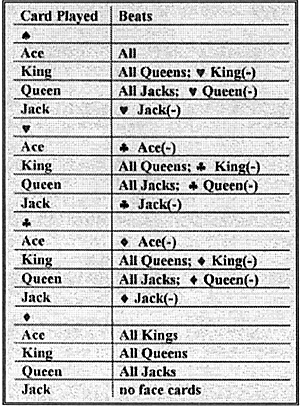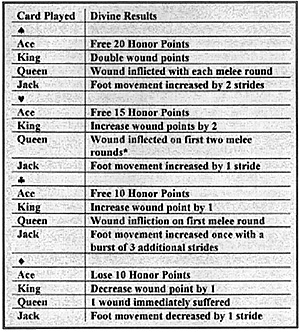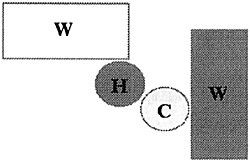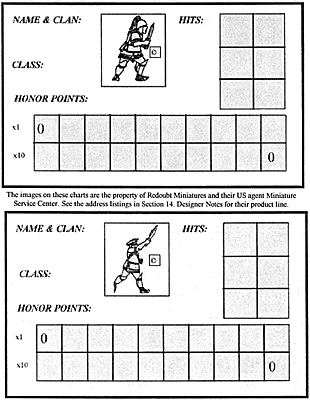14.3 Charts and Annexes:
14.3.1 Raid & Battle Setup.
14.3.2 Combat Results Chart.
14.3.3 Divine Intervention Chart.
14.3.4 Honor Points Chart.
14.3.5 Honor Point Rank Chart.
14.3.6 Clans & Names.
14.3.7 Multiple Melee Example.
14.4 Playing Aids - Hero Record
Chart
These rules page and its contents* are the property of the author, Don Wolff, who reserves any and all commercial rights. Contents may be freely distributed for personal use. * Images on the Hero Record Chart are the property of Redoubt Enterprises, UK. The author makes no claim whatsoever on these images. Armati is the property of Arty Conliffe. DBx is the property of Phil Barker and Richard Bodley Scott.
Melee Card Play: Face card inflicts one wound

1. all lower class suits and order.
2. Divine Intervention selection. A player may receive a Divine Intervention (DI) result of
increased melee wound infliction.
Numbered Cards. When two numbered cards are played against each other, highest card (number and suit) wins. The low card holder suffers an impact. The stand suffering a impact result must move back one stride for each numerical difference from the higher card. i.e. 9 spade versus a 5 club, would cause the loser to move back 4 strides. The impact strides may be distributed:
- a. The target must under any circumstance be pushed back at least 1.
b. Then distribute the difference pushing back other clan elements [loss of morale]
c. or move forward your clan elements [gain of morale]
d. but no more than one stride per element with the exception of the target stand/element.
Divine Intervention (DI). Only Aces and face cards have an effect. DI is an implementation of a individual having a 'Good Day' or 'Bad Day', rather than some 'mythical' supernatural ability. This is more in line of a major sports figure bring in the 'groove' or on 'controlled substances'. The Ace effect is the play of cultural and group importance in morale reflected in practicing religious beliefs and superstitions properly. Only the Hero and his Honor Points are effected by Divine Intervention results.

All Number Cards - "The number you called cannot be completed. Please hangup and try again" [in another session]
* In each separate melee, the DI holder inflicts a wound, regardless of card draw, for the first two draws. All subsequent wound infliction must rely upon the draw of the cards for effects.
| Category | Battle | Raid |
|---|---|---|
| Kills | ||
| Class 4 Hero | 40 | 20 |
| Class 3 Hero | 30 | 15 |
| Class 2 Hero | 20 | 10 |
| Class 1 Hero | 10 | 5 |
| Companion | 5 | 2 |
| Warbands | 2 | 1 |
| Wounds | ||
| Class 4 Hero | 5 | 1 |
| Class 3 Hero | 4 | 1 |
| Class 2 Hero | 3 | 1 |
| Class 1 Hero | 2 | 1 |
| Companion | 1 | - |
| Booty | ||
| Chariot (capture) | 50 | 25 |
| Chariot (loss) | -50 | -25 |
| Hero Armor (capture) | 15 | 7 |
| Refusing Challenge* | ||
| Class 4 Hero | -10 | -3 |
| Class 3 Hero | -5 | -2 |
| Class 2 Hero | -2 | -1 |
| Class 1 Hero | -1 | - |
* A challenge from a Hero who received Divine Intervention increased ability to inflict wounds or absorb additional hits may be refused without loss of Honor Point
| Failure to Show** | Battle | Raid |
|---|---|---|
| Sulking in Tent or Consorting with Helen | -10 | -5 |
** Participants in the Saga as officially recorded by the Herald, Chapter 5, who fail to show at a previously scheduled session have their overall Saga Honor Points reduced by these amounts.
Divine Interventiom Consult the Divine Intervention Chart for adjustments to Honor Points.
401 + Points - Homeric Hero Basileus
Your story is sung in long pentameter by the ancient Bard. Classical designs imprint your image. Neo-classical scholars debate your historical existance. Amateur archologists hunt your palace. Hollywood contemporizes your tale for the Big Screen. Garners write rulesets on your exploits. Game Manufactures resurrect you in fine 28mm, pewter.
301-400 Points - Class 4 Hero aka Champion
Long pentameter passages in the Great Saga recite your moments of glory. You appear on vases and mosaics of classical times, but only behind the Big Guy. Classical literature instructors debate whether to make you an obscure question on the next exam. You appear as the subject of an small budget art film played at last years Apsen Film Festival. Gamers at least include your name in their rulesets. Line manufactures include some representation in 15mm lead as a bag set of command figures.
201-300 Points - Class 3 Hero aka Esquire
You are among the honored clans acknowledged in the unabridged version of the tale. You appear vaguely as a line drawing in the latest edition of the period WRG book "Friends and Enemies of ......" Students debate why they are even exposed to your name. You appear as a supporting character in a Hollywood remake of a 1950s Steve Reeves movie. A Garner writes an extensive letter to MWAN arguing that your obscure story constitutes justification for some really long convoluted modification to a popular ruleset. An off brand caster convinces an art student to fashion some figure to represent your class.
101-200 Points - Class 2 Hero aka Leader of Men
Your nearest association with the whole thing is as part of the host to fight before the gates. Your name appears plastered on the side of a spaceship in Bablyon 5. At least they know what B.C.E. stands for! Some gamers attempt to modify an existing figure to give you existance.
1-101 Points - Class I Hero aka Lucky Pierre Hetatroi
You're not even a belch of Homer Simpson. You're name pops up as a background character in Hercules or Xena. Well, you can always be an old Minifig. They all looked the same back then, right?
To assist the players in developing appropriate characters, the following names were derived from the Iliad and other related tales of the great siege.
Mycenian
Boeotians - Tisamerms, Leitus, Harpalion, Promachus, Macon, Alastor, Timias
Phocians - Schedius, Ascalphus, Crisus, Panopeus, Phidias, Aegeus
Locrians - Little Ajax, Medon, Sagaris, Aethhus, Temolus, Hypsenor
Euboians - Elephenor, Acomn, Canethus, Socus, Selagus, Cimone
Atheanians - Acamas, Demophon, Stichius, lasus, Pheides, Peteos, Bias
Salamis - Ajax, Teucer, Clitus, Phocus, Opites, Elatus, Orus
Argos - Orestes, Aletes, Talthybius, Haliscus, Dias, Copreus, Demodocus
Mycenai - Nicostratus, Megapenthes, Aethiolas, Morrhaphius, Helems
Pylos - Antilochus, Aretus, Stratichus, Idas, Pisus, Epilaus
Arcadian - Melanion, Partbenopaeus, Aepytus, Everes, Alcmacon, Arsinoe
Cretans - lphiculus, Leucus, Alastor, Deipyrus, Apterus, Lycastus
Ithicians - Telemachus, Archesilaus, Elpenor, Philoetius, Mentor, Sinon
Misc - Arcesukaos, Bathycles, Clonios, Deiochos, Echios, Epeigeus, lasos, Lycohoon, Mecisteus, Medon,
Meges, Stichios, Schedios
Trojans
Trojans - Hector, Paris, Polydamas, Agenor, Amphimachus, CeIriones
Dardanians - Aincias, Archelochos, Acamas
Zeleia - Pandros
Adresteia - Adrestos, Amphios
Percote - Asios
Pelaigian - Hippoinoos
Thracian - Deipylus, Polydorus, Asius, Stentor, Peiros, Rhigmus, Laogonus
Ciconian - Euphemos
Padonians - Pyraichmes
Paphlagonians - Pylaimenes
Alizones - Odios, Epistrophos
Mysians - Eurypylus, Tarchon, Dolops, Actaeus, Chromis, Aretus, Haemus
Phrygians - Ascanius, Phorcys, Polydus, Melanippus, Abas
Meionias - Mesthles, Antiphos
Cariaus - Nastes, Amphimachus, Caunus, Nymphaeus, Aesepus, Astyalus
Lycias - Glaucus, Scylceus, Adrestus, Prytanis, lpheus, Hippolochus
Misc - Abymnios, Areilycos, Astyanax, Caletor, Cebriones, Cleitos, Croismos, Dolops, Erymas,
Hippotion, Hyperenor, Hyrtios Gyrtiades, Ilioneus, Laodamas, Lycon, Maris, Mcdon, Mermeros, Morys,
Phalces, Pronoos, Pylartes, Pyracichmes, Thoas
and by special request, the Amazons
Thermodon - Penthesilcia, Clonie, Polemusa, Derinoe, Evandre, Antandre, Bremusa, Hippothoe,
Harmothoe, Alcibie, Derimacheia, Antibrote, Thermodosa, Hippolyte
Multiple Melee Resolution
MMRI. When multiple stands of antagonist and protagonist are in contact, melee is still resolved by pairings of card draws. A simple example would be a Hero stand in contact with both an antagonist companion and warband stand. In this case, the Hero would draw two cards against the companion and three cards against the warband. Conversely, both the companion and warband would draw one card apiece against the Hero. Cards are only drawn against stands in physical contact.
MMR2. Highest card not only wins the melee but also establishes the sequence of the melee resolution. Melees are resolved in the order of priorty of suit and ranking as shown on the Combat Results Chart (CRC). As per the CRC, aces and face cards inflict wounds and number cards inflict impacts. Matching number cards result in no effect (i.e. a 10 of spades and 10 of diamonds are draw in melee) and, limited to this type of draw, stands would remain in contact unless effected by other melee resolution results or divine intervention.
MMR3. If contact is broken, no melee occurs. Since sequencing of melee resolution is determined by highest card, a situation can arise in which an impact will permit a player to pushback antagonist stands out of melee contact. Additionally, within a multiple melee, a stand can be Hied before other stands can effect or be effected by the eliminated stand. Since these multiple melees may involve multiple clan members, it is possible for one owner of a clan to decouple a melee of other protagonist by moving stands of the antagonist clan in his melee, through impact or elimination. N.B. Hero Points can only be attained by the clan Hero, so he/she must be the one inflicting the wounds or the kill in combat to garner points.
 MMR4. Example. Trojans are white outlined stands and Mycenians are gray filled in stands,
coded 'H' for Hero, 'C' for Companion, and 'W' for Warband. For the purpose of this example
stands are in contact. The Trojan Warband and Companion are in contact with the Mycenian
Hero. The Trojan Companion is also in contact with the Mycenian Warband. In resolving the
melee, the Mycenian Hero draws three cards against the Trojan Warband and two cards against
the Trojan Companion. The Trojan Warband and Companion each draw one card against the
Hero. The Trojan Companion draws two cards against the Mycenian Warband. The Mycenian
Warband draws one card against the Trojan Companion. Based upon NEMR2, the following
sequencing would happen with these draws:
MMR4. Example. Trojans are white outlined stands and Mycenians are gray filled in stands,
coded 'H' for Hero, 'C' for Companion, and 'W' for Warband. For the purpose of this example
stands are in contact. The Trojan Warband and Companion are in contact with the Mycenian
Hero. The Trojan Companion is also in contact with the Mycenian Warband. In resolving the
melee, the Mycenian Hero draws three cards against the Trojan Warband and two cards against
the Trojan Companion. The Trojan Warband and Companion each draw one card against the
Hero. The Trojan Companion draws two cards against the Mycenian Warband. The Mycenian
Warband draws one card against the Trojan Companion. Based upon NEMR2, the following
sequencing would happen with these draws:
First Round
Trojan Warband: 6/Hearts
Mycenian Heroi Jack/Spades, 4/Spades,
4/Clubs
Mycenian Hero: Jack/Clubs,
7/Spades
Trojan Companion: King/Clubs
Trojan Companion: Queen/Spades,
2/Diamonds
Mycenian Warband: 5/Spades
High Card is the King/Clubs. Trojan Companion inflicts I wound on Mycenian Hero.
Next High is Queen/Spades. Trojan Companion inflicts I wound on Mycenian
Warband.
Next High is Jack/Spades. Mycenian Hero inflict I wound on Trojan Warband.
Second Round
Trojan Warband: 5/Hearts
Mycenian Hero: King/Hearts, 7/Hearts, 7/Clubs
Mycenian Hero: Jack/Diamonds, 6/Diamonds
Trojan Companion: 8/Hearts
Trojan Companion: Ace/Hearts, 10/Clubs
Mycenian Warband: Ace/Clubs
High Card is Ace/Hearts. Trojan Companion inflicts I wound on Mycenian Warband.
Next High is King/Hearts. Mycenian Hero inflicts I wound on Trojan Warband.
Next High is Jack/Diamonds. Mycenian Hero inflicts I wound on Trojan Companion.
Third Round
Trojan Warband: 9/Clubs
Mycenian Hero: 7/Diamonds, 5/Diamonds, 3/Hearts
Mycenian Hero: Ace/Spades, 2/Clubs
Trojan Companion: 2/Hearts
Trojan Companion: King/Spades, 8/Clubs
Mycenian Warband: 10/Hearts
High Card is Ace/Spades. Mycenian Hero inflicts 1 wound on Trojan Companion.
Next High is King/Spades. Trojan Companion inflicts 1 wound on the Mycenian Warband.
This is the third wound on the Mycenian Warband and it is removed from play.
Next High is 9/Clubs. The Trojan Warband inflicts an impact of 2 strides on the Mycenian
Hero (9-7=2) The first stride must be played against the Mycenian Hero forcing him back. Contact
is broke with all remaining stands. To keep the melee going, the Trojan player uses the second stride
to move the Trojan Companion back into contact with with the Mycenian Hero.
Fourth Round
In the movement sequence of this round, the Trojan player elected to move his Warband back
into contact with the Mycenian Hero.
Trojan Warband: Queen/Clubs
Mycenian Hero: Queen/Diamonds, 9/Hearts, 9/Diamonds
Mycenian Hero: 6/Spades, 4/Hearts
Trojan Companion: 3 Diamonds
High Card is Queen/Clubs. The Trojan Warband inflicts I wound on the Mycenian Hero.
Next High is 6/Spades. The Mycenian Hero inflicts an impact of 3 strides on the
Trojan Companion (6-3-3). All three strides are applied against the Trojan Companion.
Fifth Round
In the missile sequence of this round, the Mycenian player attempted missile fire against the unengaged Trojan Companion without success, The Trojan player elected to move his
Companion back into melee contact.
Trojan Warband: Ace/Diamonds
Mycenian Hero: 8/Diamonds, 6/Clubs, 2/Spades
Mycenian Hero: Queen/Hearts, 10/Diamonds
Trojan Companion: 8/Spades
High Card is Ace/Diamonds. The Trojan Warband inflicts 1 wound on the Mycenian Hero.
Next Card is Queen/Hearts. The Mycenian Hero inflicts 1 wound on the Trojan
Companion. This is the third wound on the Trojan Companion and it is removed from play.
Sixth Round
Trojan Warband: 3/Hearts
Mycenian Hero: 10/Clubs, 5/Hearts,
5/Diamonds
High Card is 10/Clubs. The Mycenian Hero inflicts an impacts of 7 strides on the Trojan Warband (10-3=7). Four strides are applied against the Trojan Warband moving it out of range to reengage the Mycenian Hero in the next round and thus ending this particular melee. The remaining 3 strides are distributed among three of the Mycenian player's other stands to bring them forward 1 stride apiece.

Gang Warfare in the Age of Bronze Rules
Back to MWAN #105 Table of Contents
Back to MWAN List of Issues
Back to MagWeb Magazine List
© Copyright 2000 Hal Thinglum
This article appears in MagWeb (Magazine Web) on the Internet World Wide Web.
Other military history articles and gaming articles are available at http://www.magweb.com